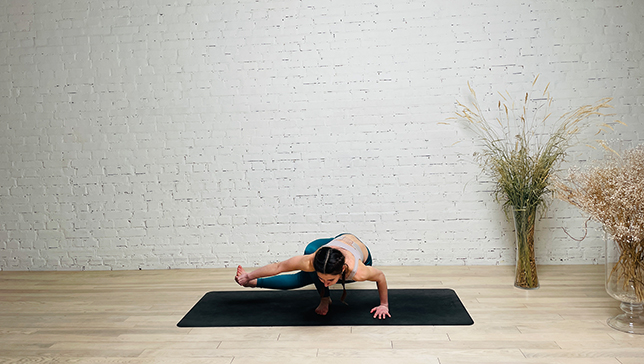Baby Grasshopper Pose - Parsva Bhuja Dandasana

Contents
Baby Grasshopper Pose or Parsva Bhuja Dandasana (pa-aar-sva-bhu-jaa-dan-dahs-anna) is a modified version of full Grasshopper or Dragonfly Pose. Here, one foot remains on the floor for stability and one leg reaches to the side while the yogi builds strength and confidence to enter the full pose. This arm balance is great for beginner to intermediate practitioners.
Balancing the body on one arm and a foot in this asana brings a twist in the spine and opens the hips. This improves flexibility and strengthening.
Pose Detail
- Body Position: Arm & Leg Support, Forward Bend Yoga Poses, Twist Yoga Poses
- By Type: Balancing Yoga Poses, Hip Opening Yoga Poses, Strengthening Yoga Poses
- Difficulty: Intermediate
Step-by-Step Instructions




Benefits and Contraindications
Helping to stimulate and nourish the reproductive organs.
Improves concentration and focus
Improves flexibility in the waist, lower back, thighs, spine, and shoulder blades.
Injury in the shoulders, elbows, or wrists
Issues with the stomach or internal organs
Pregnancy
High blood pressure
Photo poses in different angles

Modifications, Props and Tips
- The pose will become much easier if you try to push most of your weight into the standing foot. To do so, make sure you engage your leg muscles and core and strongly push the foot into the ground.
- Keep the lifted foot flexed. This will not only protect the knee but will also help you when you lift off the mat.
- Keep the palm of the arm that’s on the floor close to your body. This allows you to keep the elbow close to the ribs.
- Spread the fingers of the bottom arm to help you with stability.
- Avoid bending the lifted leg. If you’re not able to keep the leg long when you grasp the foot, use a strap to extend your reach.
- If you’re afraid you will fall, place a cushion in front of your head to protect you.
Frequently Asked Questions
No, Baby Grasshopper Pose is an intermediate-level pose that requires a strong foundation in arm balances and hip-opening poses. It is recommended that beginners build up to this pose gradually with the guidance of an experienced yoga teacher.
If you are unable to lift your hips off the ground, you can practice Half Baby Grasshopper Pose, where you keep one leg extended and one knee bent. You can also practice this pose against a wall for added support.
Avoid forcing your body into the pose or straining your arms and shoulders. It is also important to avoid practicing this pose if you have any injuries or conditions that may be aggravated by arm balances or hip-opening poses.
Once you have mastered Baby Grasshopper Pose, you can work on straightening your arms and lifting your torso higher off the ground. You can also try transitioning from this pose to other arm balances, such as Flying Pigeon Pose or Side Crow Pose.
Variations
- Grasshopper Pose
- Mating Grasshopper Pose
- Grasshopper Pose With Blocks